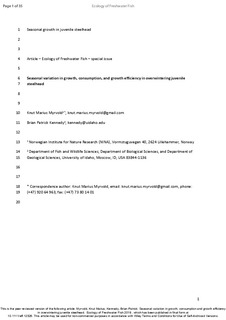Seasonal variation in growth, consumption and growth efficiency in overwintering juvenile steelhead
Peer reviewed, Journal article
Accepted version

View/
Date
2019Metadata
Show full item recordCollections
- Scientific publications [1423]
Original version
10.1111/eff.12526Abstract
Food availability and thermal regimes can largely govern growth opportunities in fishes. In temperate regions, streams can exhibit summer temperatures that exceed the optima for coolwater-adapted species relative to the amount of available food, and therefore, spring and fall may confer better growing conditions, especially for larger size classes. We examined the relationship between growth, consumption and growth efficiency across seasons in juvenile steelhead (Oncorhynchus mykiss) in their natal streams in Idaho, USA. Subyearling (0+) growth rates were higher in summer, whereas yearlings exhibited no statistically significant difference in growth between seasons. Consumption rates were overall lower in winter–spring but constituted a higher proportion of maximum consumption compared with summer and fall, indicating better food availability relative to metabolic demands. Net growth efficiencies were higher in winter–spring, but substantially more so than the proportion of maximum consumption. This suggests that overwinter growth performance was driven at least partly by higher growth efficiency, and the effect was most pronounced for yearling steelhead. The low proportions of maximum consumption for both age classes suggest that food was an overall limiting factor to growth, especially in summer when metabolic demands were highest. We discuss how temperature-based models can overestimate growth in the warmest parts of the year and develop a simple conceptual model for the seasonal timing of juvenile growth. In anadromous populations, the outmigration of presmolts in spring can reduce the level of competition. For the individuals that remain in the river, growth in this period can be particularly important.